02 May 2022
Have you ever seen a video of Aloe vera being harvested? If you haven’t, I highly recommend you do! You won’t be disappointed. Inside the leaves of this desert succulent is a soothing jelly that humans have used for millennia to treat rashes, sunburns, and wounds. Workers harvest the jelly by slicing off the tough outer epidermal layer of the plant, leaving fully intact triangular sections of gel. It makes for a very satisfying watch.
Humans have been using aloe for millennia. Its first recorded use comes from an ancient Mesopotamian tablet dated 2100 BCE, and aloe is found in traditional medicines from Japan, China, India, West Indies, and South Africa. Nowadays, Aloe vera is one of the most widely used herbal remedies around the world. Botanists describe the desert plant as a perennial succulent xerophyte. Meaning it is a long-lived (perennial) desert plant (xerophyte) adapted to growing in dry conditions by storing water in its thick fleshy tissue (succulent). The triangular fleshy leaves of Aloe Vera contain three layers; a thick outer layer called a rind, a middle latex layer containing bitter yellow sap, and an inner gel layer made up of 90 % water (Surjushe 2008).

The rind plays an essential role in protecting the plants from losing water and facilitating photosynthesis. It’s composed of a cuticle, epidermis layer, palisade cells, and several layers of parenchyma cells. The middle layer contains bundles of tubelike vascular tissue, which acts as the plumbing for the plant. These pipes help transport water from the soil to the leaves and sugars from the leaves to the rest of the plant; surrounding these tubes are bundle sheath cells. Within the vascular bundle are aloin cells, which accumulate large quantities of anthraquinones in their vacuoles producing a yellow sap substance often called “aloe” or “latex”. Anrthoquinones have many interesting medicinal properties, including acting as a potent laxative.
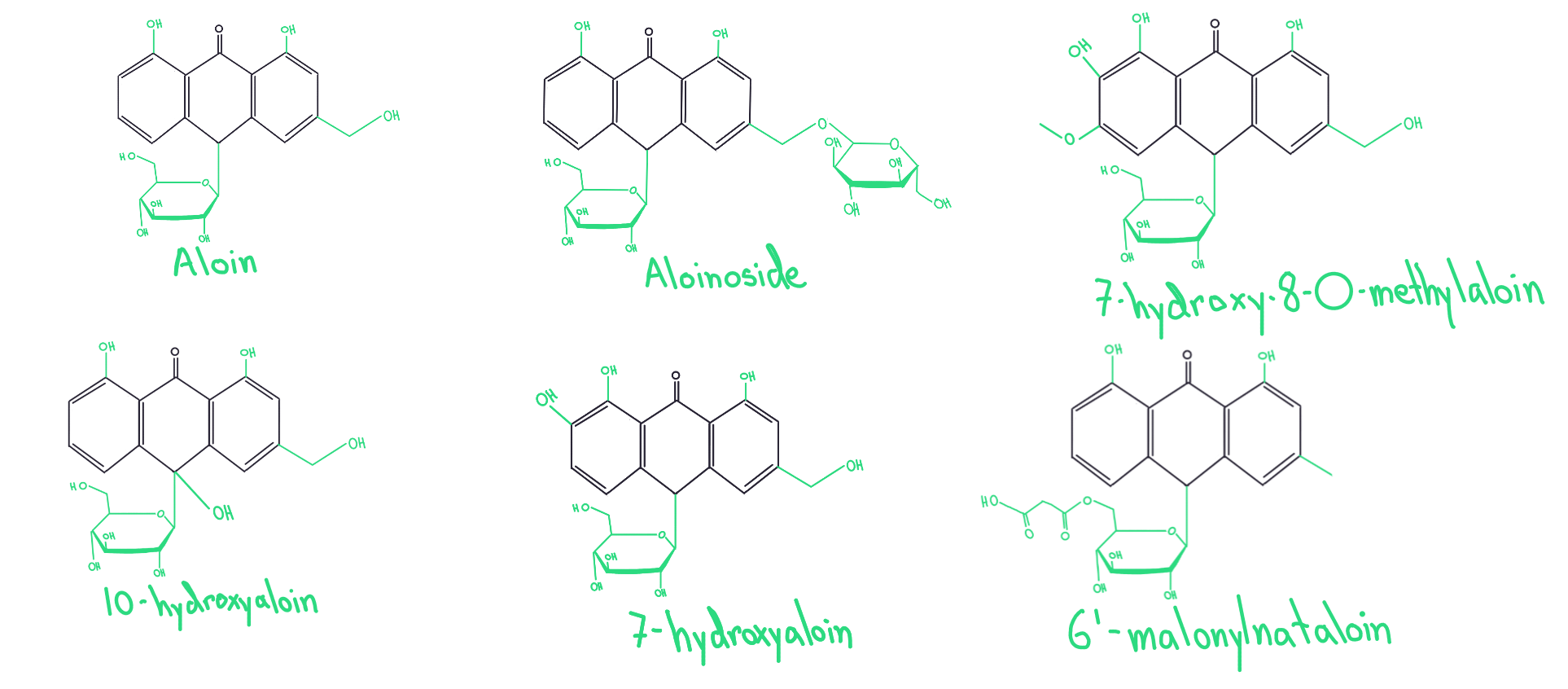
A quick aside: Our friends at the Mayo clinic recommend against ingesting any aloe product, especially the yellow latex sap, as it can cause severe cramps and diarrhea (obviously). So, if you need a laxative, please just go to the drug store and ask your pharmacist.
The tissue in the innermost layer is made of mucilaginous parenchyma, large thin-walled cells filled with water and complex carbohydrates. Much like the mucilage of chia seeds, discussed in an earlier post, these complex carbohydrates, or polysaccharides, help form a hydrophilic matrix that can retain water and allow the aloe plant to survive arid environments with sporadic rainfall. In aloe, the predominant polysaccharide making up this matrix is typically acemannan, which is a long chain of repeating units of the monosaccharide mannose (Hamman 2008). This chain is interspersed with glucose units. The mannose units are all decorated with an extra acetyl group. Galactose side chain decorations can also be found attached to mannose units (Lui et al. 2019).
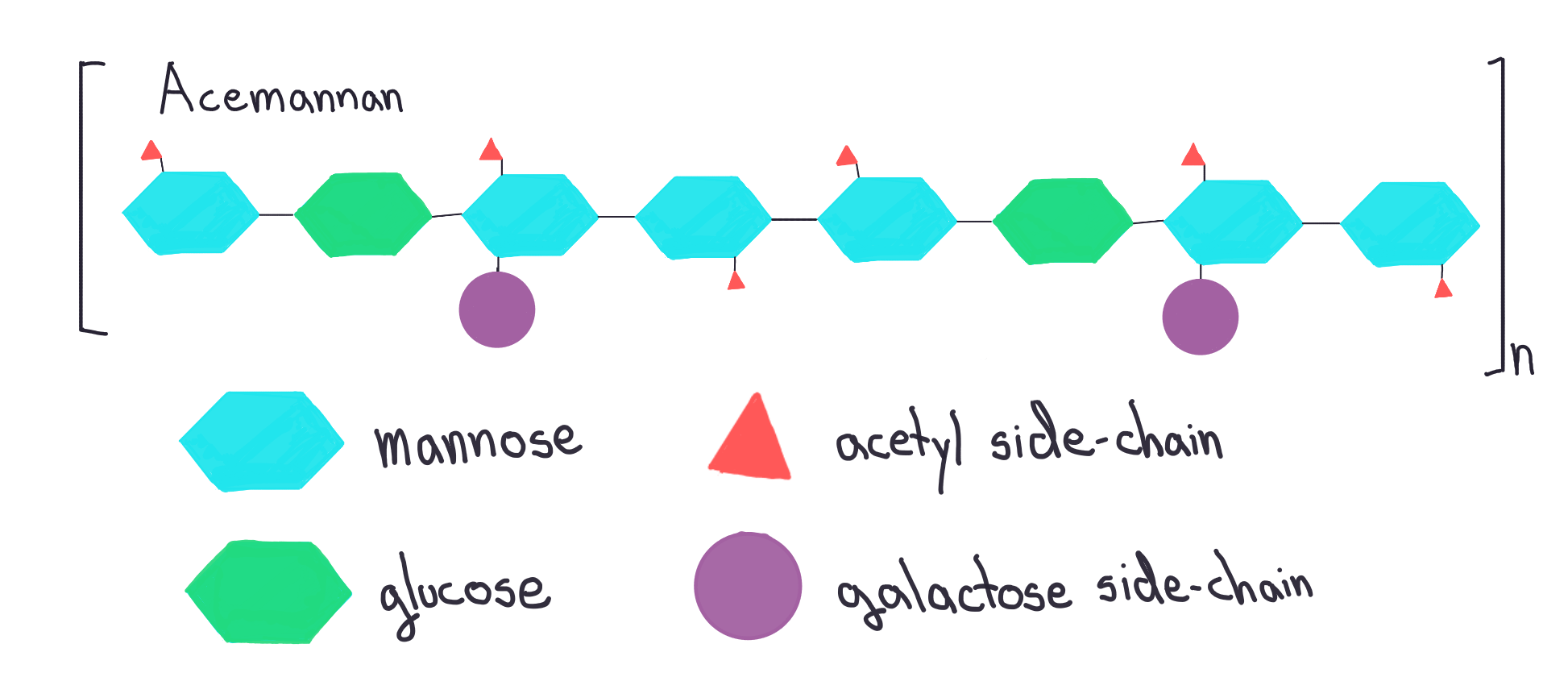
This acemannan found in Aloe vera is unique to the Aloe genus and, unlike other plant mannans, is relatively soluble. What’s more, humans can’t break down the B-(1-4) glycosidic bond in the acemannan backbone, making it ideal for therapeutic uses because it isn’t broken down before it can take medicinal effect. Studies have shown that acemannan has anti-cancer activity, and neuroprotective benefits. It can even regulate the immune response in mouse cell cultures (Lui et al. 2019). What’s more, acemannan is reported to promote wound healing and bone regeneration and is currently being tested in dental surgeries (Boonyagul et al. 2014).
As I mentioned earlier, Aloe vera is one of the most widely used herbal remedies today. If you’ve ever had a sunburn, you may have relied on the gel on your skin for soothing relief, and soon you even may benefit from the biochemistry of Aloe Vera at the dentist!
Bonus Reading:
Boonyagul, Sani, Wijit Banlunara, Polkit Sangvanich, and Pasutha Thunyakitpisal. “Effect of acemannan, an extracted polysaccharide from Aloe vera, on BMSCs proliferation, differentiation, extracellular matrix synthesis, mineralization, and bone formation in a tooth extraction model.” Odontology102, no. 2 (2014): 310-317.
Hamman, Josias H. “Composition and applications of Aloe vera leaf gel.” Molecules 13, no. 8 (2008): 1599-1616.
Liu, C., Cui, Y., Pi, F., Cheng, Y., Guo, Y. and Qian, H., 2019. Extraction, purification, structural characteristics, biological activities and pharmacological applications of acemannan, a polysaccharide from aloe vera: A review. Molecules, 24(8), p.1554.
Surjushe, Amar, Resham Vasani, and D. G. Saple. “Aloe vera: a short review.” Indian journal of dermatology 53, no. 4 (2008): 163.
18 Apr 2022
Blue rosese are a symbol of the impossible. From Tennessee William’s “Glass Menagerie” to David Lynch’s “Twin Peaks,” they have been used to represent the allure of strange beauty and supernatural secrets throughout literature and pop culture. These flowers can be used to symbolize the alien and unattainable. They are also famously the most challenging type of rose to breed in Animal Crossing: New Horizons.
Blue roses have earned this reputation for unattainability because they are impossible to breed naturally. They are the unicorn of flowers. The ones you purchase at the florist are usually white roses dyed blue, much like a horn strapped to the head of a white horse at the county fair. We all know it’s not a real unicorn, but we go along with it because it keeps the children happy.
Flower breeders have been working for decades to cultivate a naturally blue rose. In 1965, a variety of lilac-colored rose, called “Blue Moon,” was introduced on the market by the German hybridist Matias Tantau. In 2003, the greyish purple rose “Misty Purple” was introduced by the Japanese rose breeder Moriji Komori, and later in 2012, a lighter mauve rose named “Seiryu” by another Japanese breeder, Junko Kawamoto (Noda 2018). However, a truly blue rose has never been achieved using traditional hybridization and breeding methods. So why is this? Many other plant species make blue flowers, such as pansies, hydrangeas, and forget-me-nots. So why not roses?
The answer lies within the rose genome. All rose species are members of the Rosa genus. Members of this genus lack a critical gene responsible for producing the anthocyanin pigment that makes floral tissues blue. Anthocyanins are a class of pigments that lend flowers a yellow, red, or blue color, depending on the chemical structure. Pelargonium-based pigments are usually yellow to orange, whereas cyanidin-based pigments are pink to red, and delphinidin-based pigments are typically blue to violet.
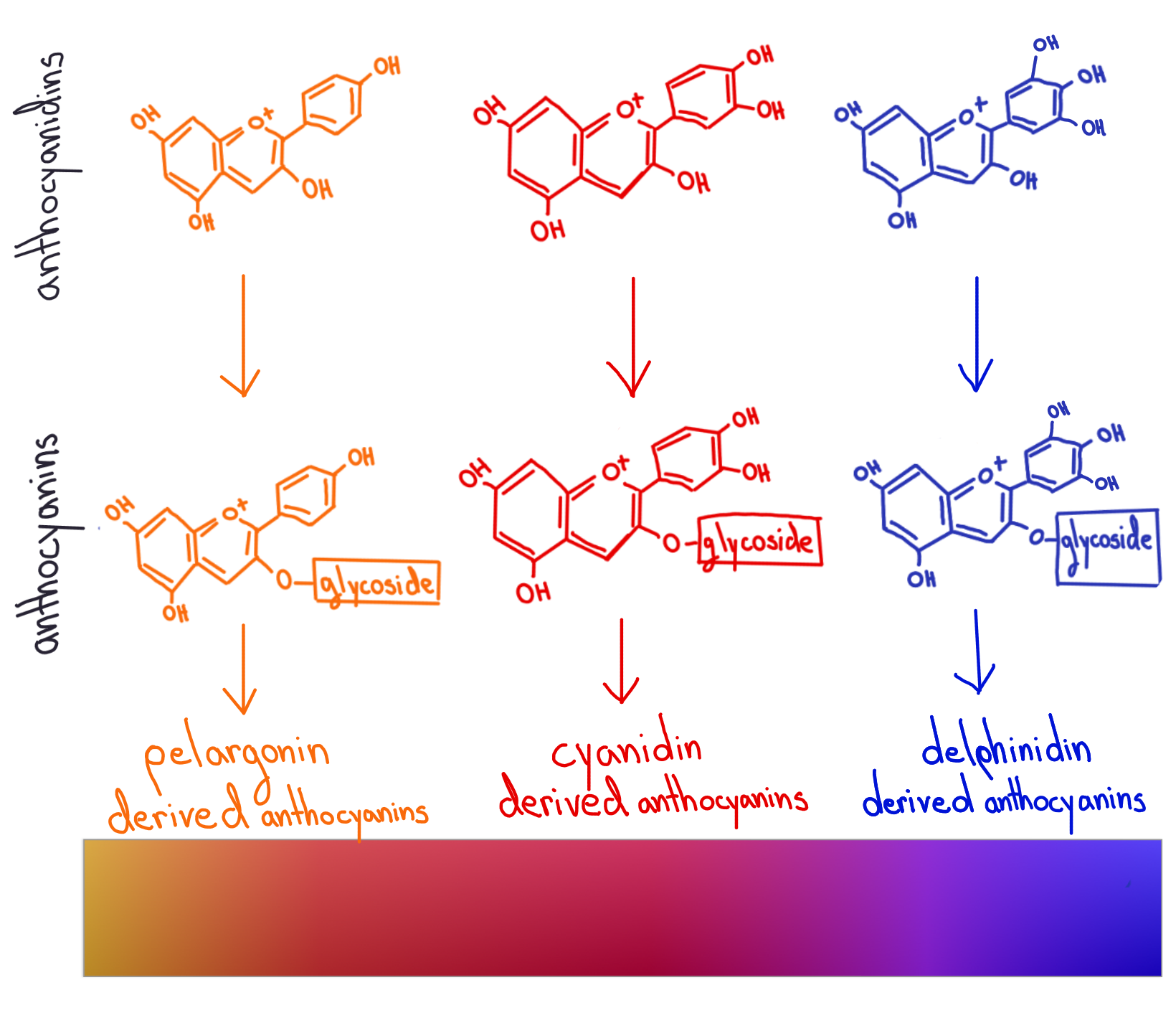
Wild roses are typically red, white, or pink. Selective breeding and hybridization efforts have led to roses of other colors, including yellow and orange. However, roses lack the flavonoid 3’5’ hydroxylase gene in their genome, which is necessary to produce delphinidin (Tanaka & Brugliera 2013). Therefore, no variety of rose, either wild or bred, can achieve a truly blue color.
Flavonoid 3’5’hydroxylases do exactly what their name suggests. They add a hydroxyl (OH) group onto the 3’ and 5’ carbons of the flavonoid precursor. The genome of roses has only flavonoid 3’ hydroxylases, meaning they are unable to hydroxylate the 5’ carbon.
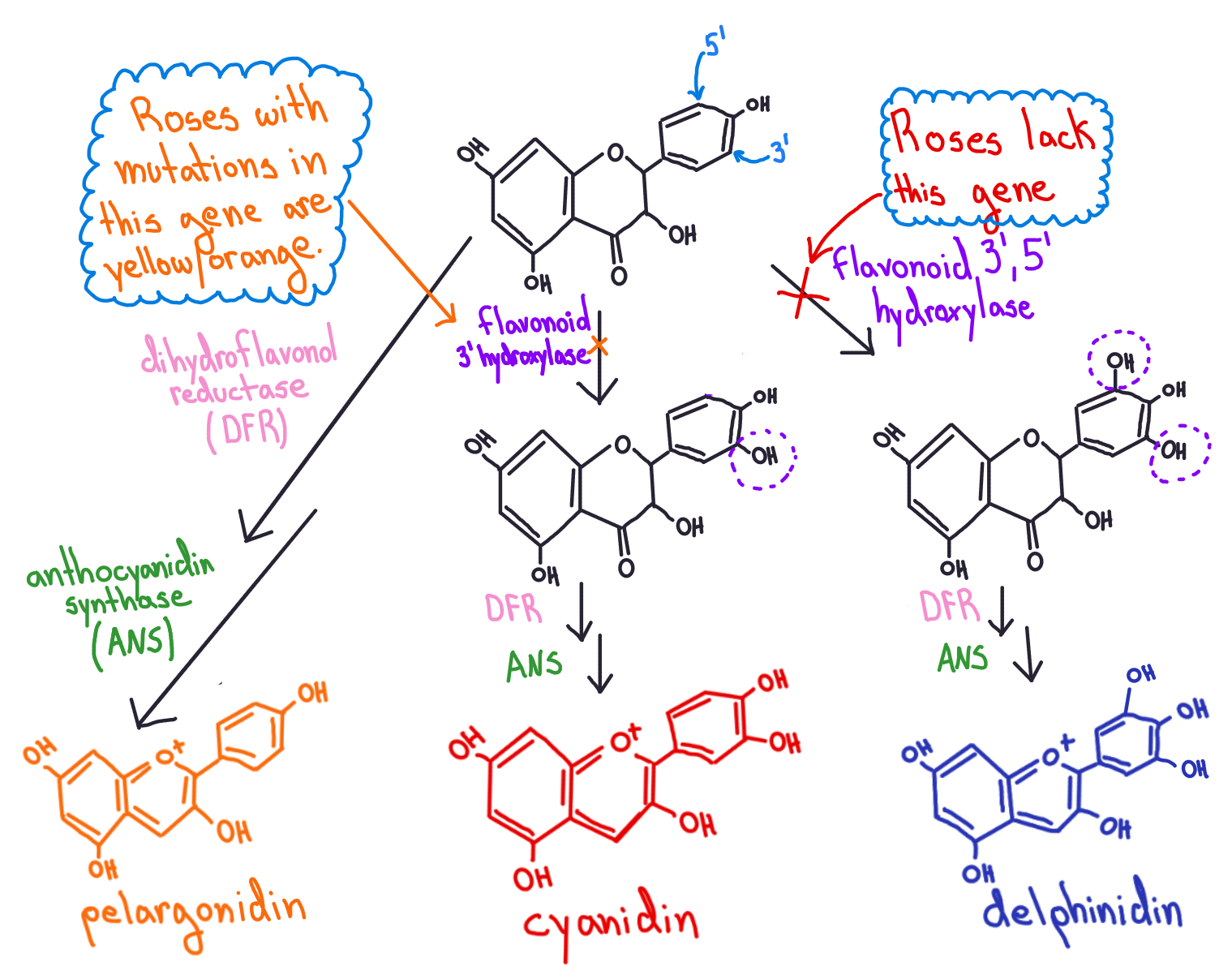
Remember how I mentioned that selective breeding of roses led to orange and yellow varieties? Researchers believe this is due to a naturally occurring mutation in the flavonoid 3’ hydroxylase. These flowers cannot make cyanidin and only produce pelargonidin leading to orange and yellow flowers (Zufall et al. 2003; Tanaka & Brugliera 2013).
In 2007, researchers at Suntory and Florigene genetically engineered roses to express an exogenous flavonoid 3’5’ hydroxylase gene taken from the pansy genome. These roses did manage to produce delphinidin. Researchers then reduced the expression of an enzyme in a competing pathway. They also added a delphinidin biosynthetic enzyme taken from the iris genome, which could act as a partner to the pansy flavonoid 3’5’ hydroxylase. The resulting roses made even more delphinidin (Komoto et al. 2007).
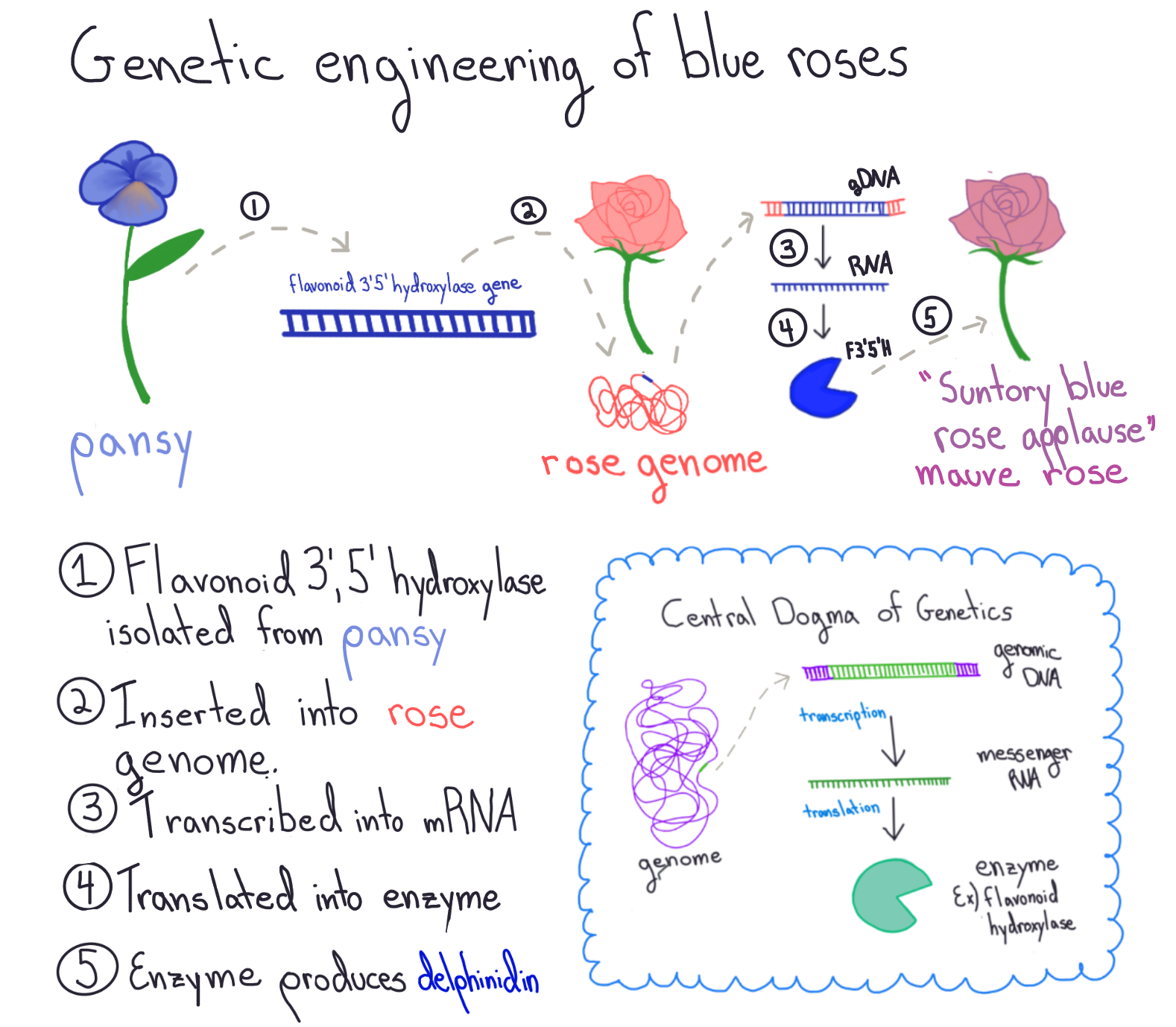
A quick side note: In genetics, when we say a gene is being expressed, it means that the gene is being transcribed into messenger RNA (mRNA), which will then be translated into a protein/enzyme. When we say that an organism has been genetically engineered to express an exogenous gene, we mean that a gene has been taken from the genome of one organism and inserted into the genome of another, where it is being transcribed and translated into a functional protein/enzyme.
However, the line of roses resulting from these genetic engineering efforts, coined “SUNTORY blue rose APPLAUSE,” were distinctly mauve, not blue. This could be because many other factors can affect petal color. For example, the acidity of the vacuole where pigments are stored inside cells can cause a color shift. In a less acidic environment, delphinidin will be bluer in color, whereas in a more acidic environment, it will be more purple in color. In addition, other co-pigments like flavones and flavonoids can enhance blue coloration when stacked with anthocyanins (Noda et al. 2018). The researchers at Suntory and Florigene considered this when they chose a background line of roses with a higher vacuolar pH (less acidic) and lots of flavonol co-pigments (Komoto et al. 2007). However, the elusive blue rose was still not obtained.
In 2019, researchers in China tried a completely different approach and demonstrated that the production of the amino acid-derived pigment indigoidine in rose petals generated truly blue pigmentation (Nanjaraj et al. 2019). This is a totally novel approach that does not rely on delphinidin and therefore produces a blue color that is not dependent on vacuolar acidity, competition from other natural rose enzymes, and interaction with co-pigments.
This could mean that a genetically engineered line of blue roses is soon to be available at a florist near you! The unicorn of the flower world is coming.
Bonus reading:
Katsumoto, Y., Fukuchi-Mizutani, M., Fukui, Y., Brugliera, F., Holton, T.A., Karan, M., Nakamura, N., Yonekura-Sakakibara, K., Togami, J., Pigeaire, A. and Tao, G.Q., 2007. Engineering of the rose flavonoid biosynthetic pathway successfully generated blue-hued flowers accumulating delphinidin. Plant and Cell Physiology, 48(11), pp.1589-1600.
Nanjaraj Urs, A.N., Hu, Y., Li, P., Yuchi, Z., Chen, Y. and Zhang, Y., 2018. Cloning and expression of a nonribosomal peptide synthetase to generate blue rose. ACS Synthetic Biology, 8(8), pp.1698-1704.
Noda, N., 2018. Recent advances in the research and development of blue flowers. Breeding science, p.17132.
Tanaka, Y. and Brugliera, F., 2013. Flower colour and cytochromes P450. Philosophical Transactions of the Royal Society B: Biological Sciences, 368(1612), p.20120432.
Zufall, R.A. and Rausher, M.D., 2003. The genetic basis of a flower color polymorphism in the common morning glory (Ipomoea purpurea). Journal of Heredity, 94(6), pp.442-448.
06 Apr 2022
Ahh, the mighty chia seed! In the 2010s, this gelatinous little seed exploded onto the health food scene, being officially named the ‘it’ food of 2013. Since then, the chia seed has found its way into breakfast cookies, seedy crackers, vegan chocolate puddings, coconut puddings, cashew puddings and … yeah mainly just a lot of non-dairy puddings. According to nutritionists, chia seeds are nutrient-dense sources of vitamins, calcium, zinc, omega-3 fatty acids, and soluble fiber. They are good for our digestion and are purported to keep us feeling fuller for longer, thanks to their gelatinous expansion when hydrated. They have even earned the title of ‘superfood’, or ‘functional food’ in more academic circles. So, do chia seeds live up to their stellar reputation?
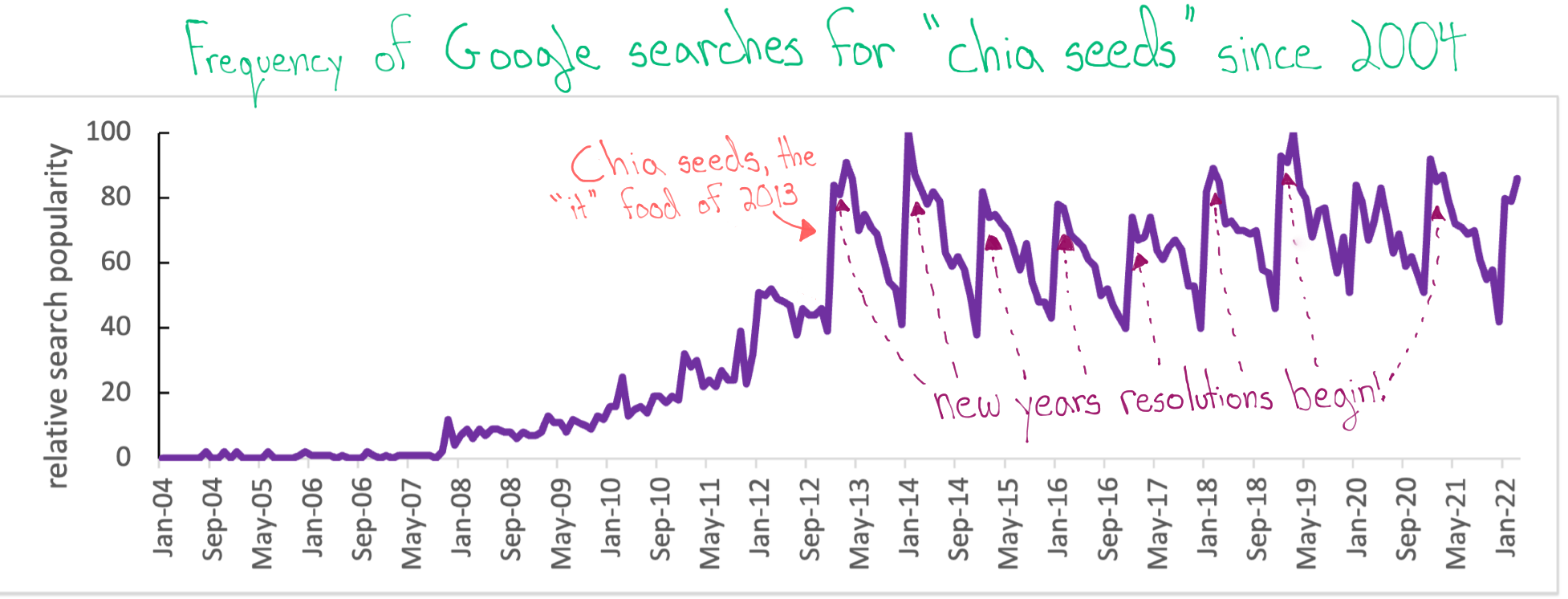
The chia plant (Salvia Hispanic L.) is a member of the mint family and is native to the semi-arid regions of Central America and Mexico (Cahill & Ehdaie 2005). When the seeds from this plant are immersed in water, they extrude a gelatinous substance called mucilage, allowing the seed to germinate in dryer desert environments. Botanists believe that mucilage sequesters water within a hydrated gel matrix of hydrophilic (‘water loving’) carbohydrates, providing moisture to the emerging seedling (Geneve et al. 2017). In fact, chia mucilage is so good at holding water that runners from the Tarahumara tribe of northwestern Mexico, famed for being some of the best ultra-marathoners in the world, are known to mix chia seeds with water, lime juice, and honey to help with maintaining hydration over long runs (McDougall 2009).
So, what is mucilage, and how is it made? Briefly, chia seeds are surrounded by a layer of hardened fruit tissue called the pericarp, meaning the seeds that you buy in the grocery store are actually called nutlets, as they include both seed and fruit tissue. As the nutlet matures, cells in the outer pericarp begin to produce the complex carbohydrates that make up the mucilage (Ryding 2001). When exposed to water, the mucilage inside the pericarp layer quickly hydrates and ruptures the cell walls on the topmost layers of the pericarp and extrudes outwards from the seed at a rate of 0.2 mm2/min (Geneve 2017). Interestingly, as the mucilage expands, it remains tethered to the lower cell wall of the pericarp, allowing the gelatinous substance to remain connected to the seed!
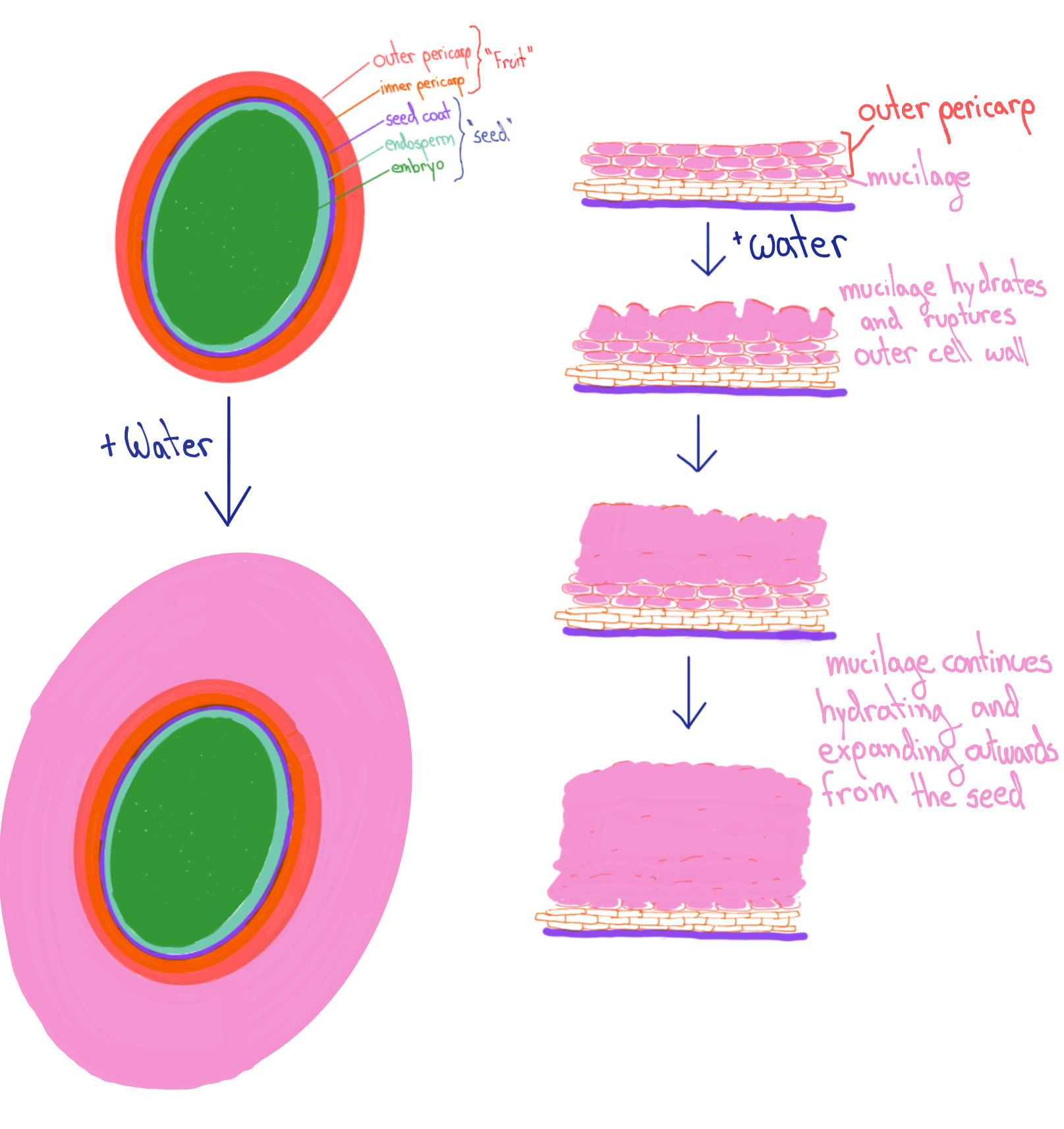
Chia mucilage is composed of several complex carbohydrate components. As you may remember from that one friend who is really into their keto diet, a complex carbohydrate is a chain of repeating sugar molecules or saccharides. Starch, for example, is a chain of repeating 1-4 linked α glucose monomers, whereas cellulose is repeating units of 1-4 linked β glucose monomers (need more background? https://www.khanacademy.org/science/ap-biology/chemistry-of-life/properties-structure-and-function-of-biological-macromolecules/a/carbohydrates).
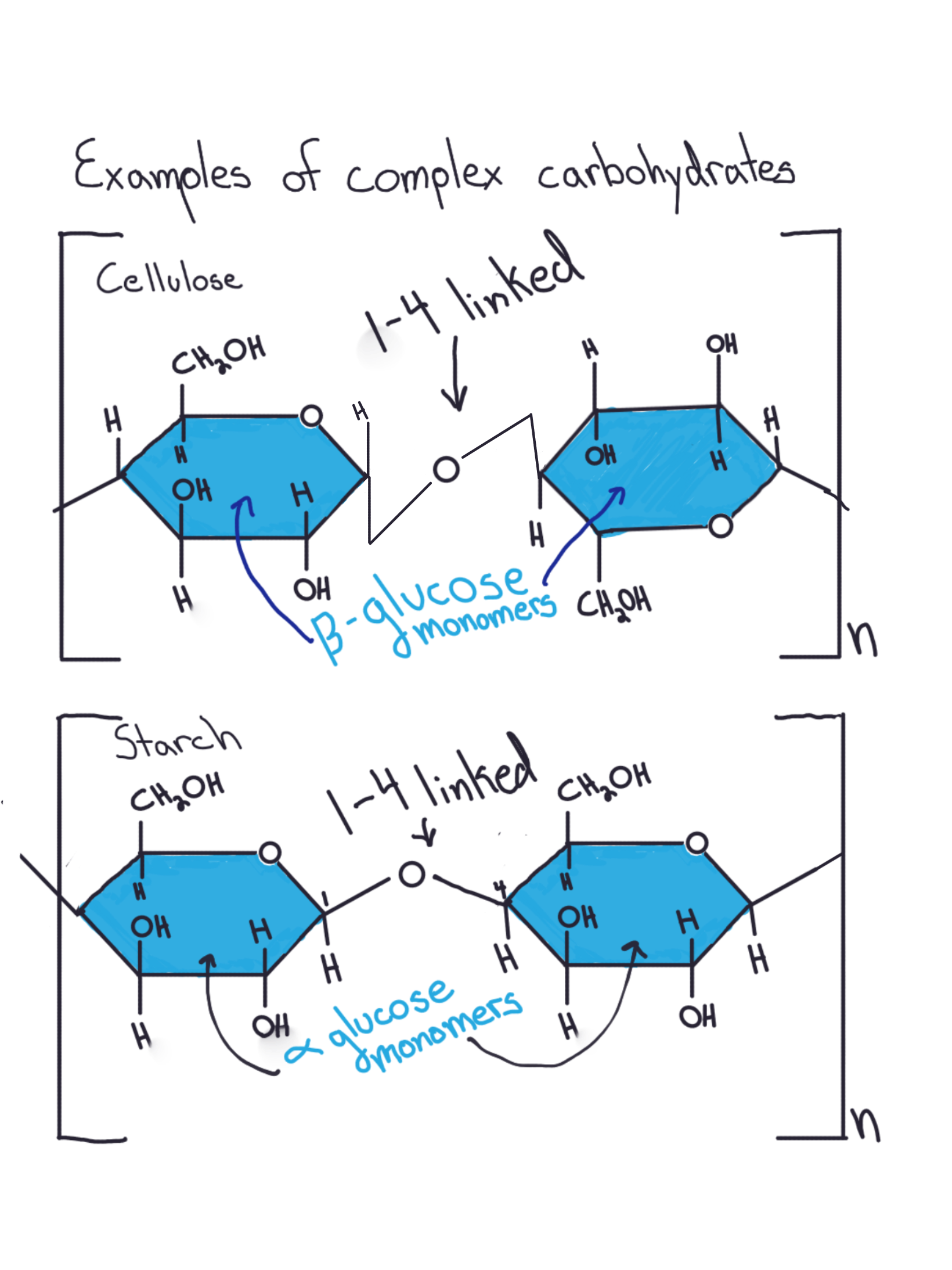
The complex carbohydrates found in the mucilage of chia seeds are a combination of cellulose, pectin, and hemicelluloses, which together form a highly hydrophilic matrix that expands when exposed to water. While cellulose is composed only of glucose units, the pectins in chia mucilage are composed of alternating units of rhamnose-glucuronic acid decorated with arabinose and galactose side-chain units (Lin & Daniel 1994;Western 2012). Hemicellulosic sugars found in chia include chains of repeating xylose, glucose-xylose, or glucose-glucose-mannose units, all of which are decorated with other saccharide side chains (Western 2012). I explain all of this to, hopefully, convince you that carbohydrates have depth and complexity deserving of our fullest appreciation (no matter what your one always irritable keto friend says).
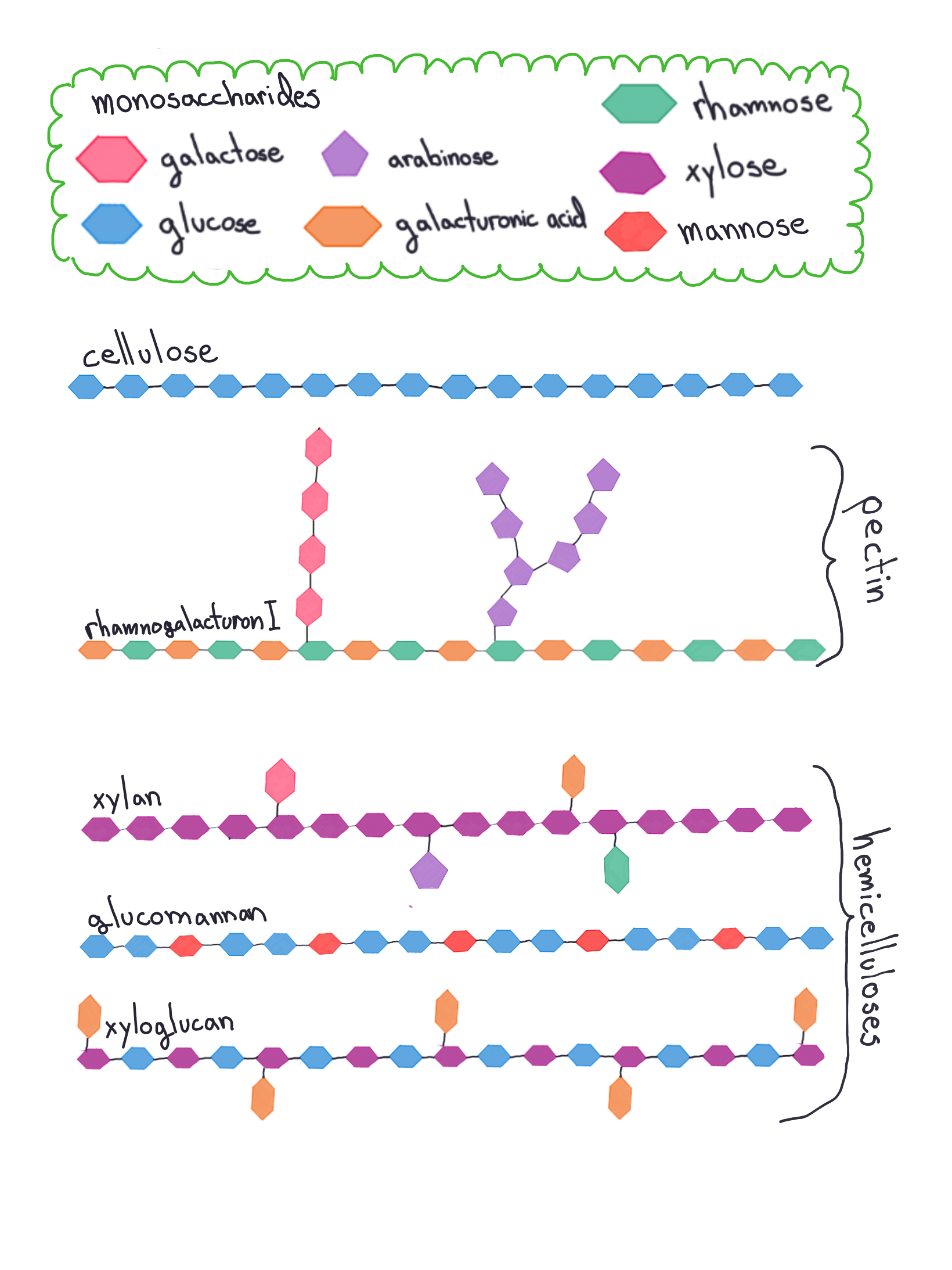
As I mentioned at the start, chia seeds have become very popular in all kinds of health food snacks. The complex carbohydrates found in the mucilage, especially pectin, have several positive health benefits, including lowering blood sugar levels, improving gut health, and managing blood pressure (Anderson 2009). However, there is also growing interest in the use of complex carbohydrates in mucilage as a natural stabilizer in foods and cosmetics (De Falco et al. 2017). Moreover, researchers are using glucuronoxylan polymers produced by the mucilage of quince seeds as a scaffold for hydrogels used in tissue engineering and wound dressings (Oran et al. 2022).
So are chia seeds worth the hype or are they just another health food fad? Hopefully, I’ve convinced you that the complex and amazing matrix of carbohydrates exuded by these magnificent little seeds makes them truly deserving of their growing popularity!
Bonus reading:
Anderson, J.W., Baird, P., Davis, R.H., Ferreri, S., Knudtson, M., Koraym, A., Waters, V. and Williams, C.L., 2009. Health benefits of dietary fiber. Nutrition reviews, 67(4), pp.188-205.
Cahill, J.P. and Ehdaie, B., 2005. Variation and heritability of seed mass in chia (Salvia hispanica L.). Genetic resources and crop evolution, 52(2), pp.201-207.
De Falco, B., Amato, M. and Lanzotti, V., 2017. Chia seeds products: an overview. Phytochemistry Reviews, 16(4), pp.745-760.
Geneve, R.L., Hildebrand, D.F., Phillips, T.D., AL-Amery, M. and Kester, S.T., 2017. Stress influences seed germination in mucilage‐producing chia. Crop Science, 57(4), pp.2160-2169.
Lin, K.Y., Daniel, J.R. and Whistler, R.L., 1994. Structure of chia seed polysaccharide exudate. Carbohydrate polymers, 23(1), pp.13-18.
McDougall, C., 2010. Born to run: The hidden tribe, the ultra-runners, and the greatest race the world has never seen. Profile Books.
Oran, D., Unal, S. and Gunduz, O., 2022. Evaluation of bacterial cellulose/quince seed mucilage composite scaffold for wound dressing. Emergent Materials, pp.1-7.
Ryding, O., 2001. Myxocarpy in the Nepetoideae (Lamiaceae) with notes on myxodiaspory in general. Systematics and Geography of Plants, pp.503-514.
Western, T.L., 2012. The sticky tale of seed coat mucilages: production, genetics, and role in seed germination and dispersal. Seed Science Research, 22(1), pp.1-25.
23 Mar 2022
Ginger has long been an essential ingredient in folk remedies around the world. In Columbia, for example, ginger is mixed with panela to treat cold and flu. Whereas, in India and Nepal ginger paste is mixed with lemon and black salt to help alleviate nausea. In fact, ginger is a common remedy cited across many traditional medicines such as Chinese, Arabic, Ayurvedic, and African (Bode and Dong 2011). So, where did this fantastic plant come from?
Botanists believe that the ginger plant is indigenous to Southeast Asia, spreading to Europe, Africa, and the Americas starting in the fourteenth century through human trading routes. However, nowadays, ginger is primarily cultivated in Latin America and Southeast Asia, and parts of Africa, where the knobbly underground part of the plant called the rhizome is harvested and used in cooking and medicine around the world (Bode and Dong 2011).

In botany, “rhizome” is a fancy word for a stem that grows horizontally underground. A rhizome is different than a root because it is fundamentally more similar to a stem. It has branches that grow from axillary buds on the surface of the rhizome rather than from within the center, the way lateral roots emerge. Rhizomes are also able to produce new shoots, unlike traditional roots. There are many examples of underground stems in our food! Potatoes, yams, and ginger are underground stems, while carrots, sweet potatoes, and radishes are just boring old roots.
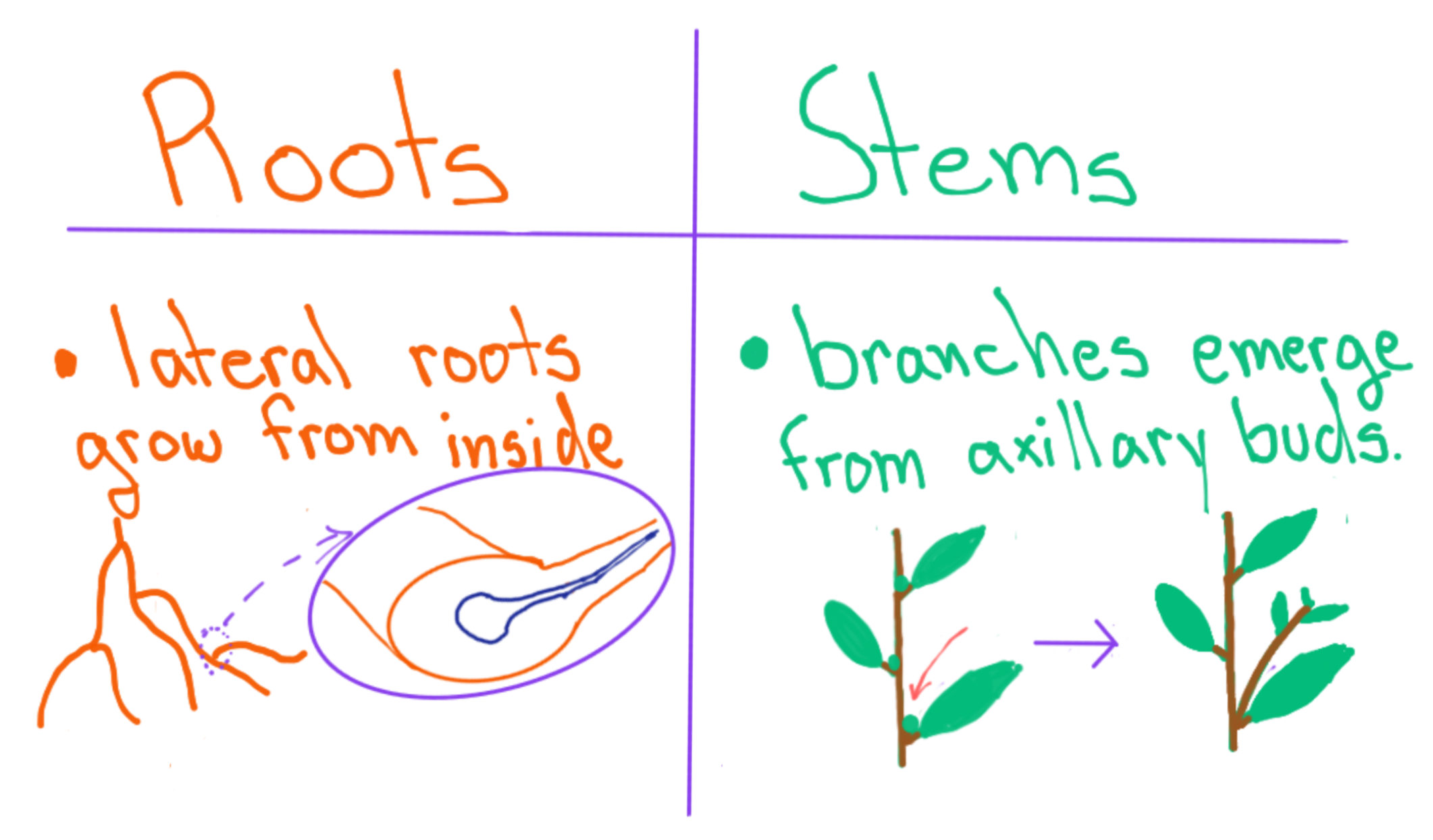
The ginger rhizome plays a vital role throughout the plant’s lifetime. Young ginger plants use their rhizomes to store starch, an important form of energy for the growing plant. As the rhizome matures, specialized secretory cells called “oil cells” start producing oil droplets. Once the oil cells are completely matured, they undergo cell death, leaving behind empty cavities fill with oil inside the rhizome (Lui et al. 2020). Dissolved in the oil droplets are a bounty of lipophilic defensive compounds such as terpenes, sesquiterpenes, and gingerols, which protect the ginger plant from pests and pathogens in the soil (Zhan et al. 2008). As the plant ages, more oil cells and subsequent oil cavities appear in the rhizome. This is why young ginger often has a milder, sweeter flavor different from more mature ginger, which is more pungent (Lui et al. 2020).
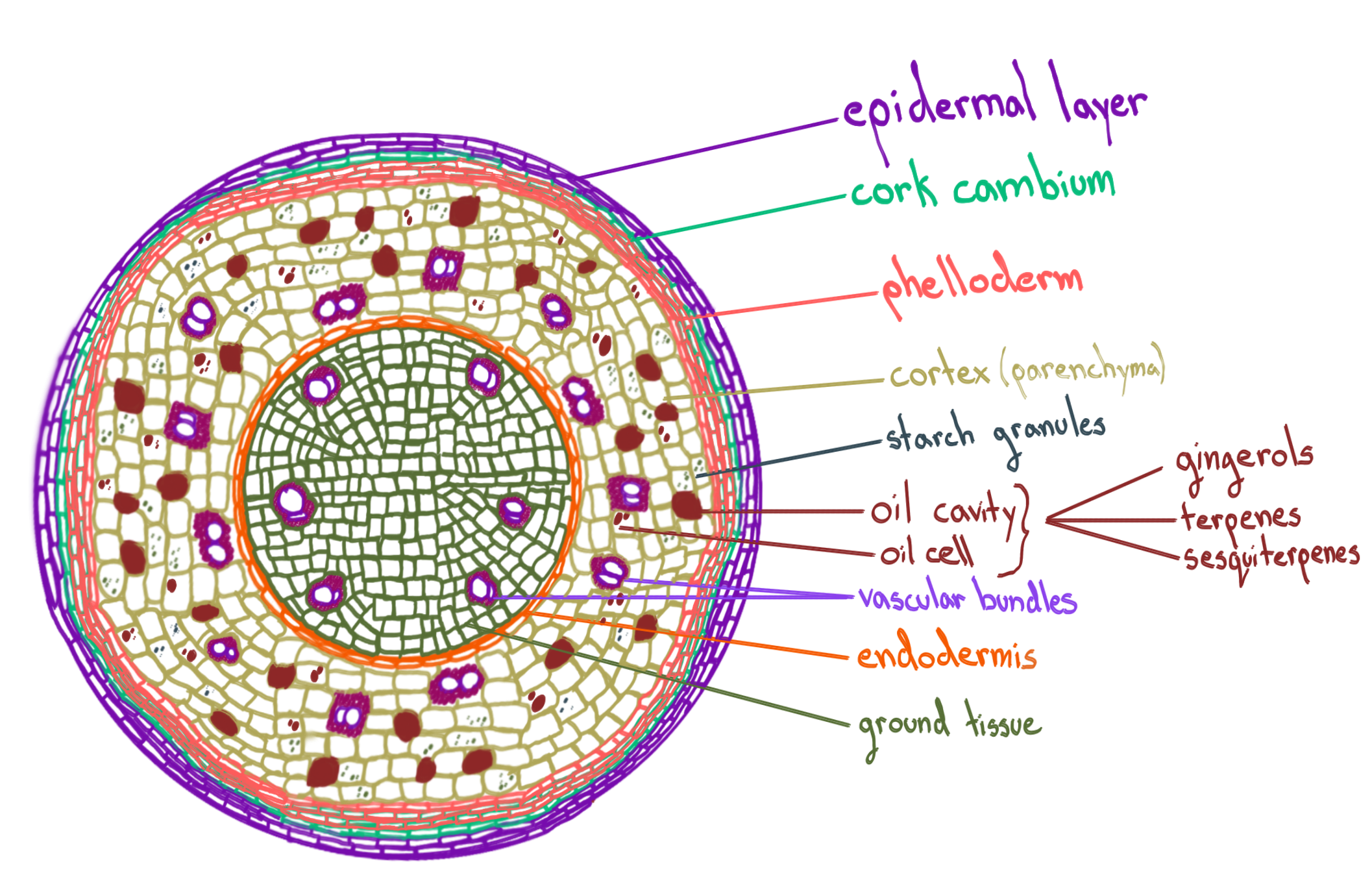
The key medicinal ingredient of ginger is a set of polyphenolics called gingerols. When gingerols are subjected to heat or drying, they lose an OH group and are converted into shogaols, which have a more pungent scent and taste. This explains why dried or cooked ginger often has a stronger gingery taste (Johnson et al. 2020).
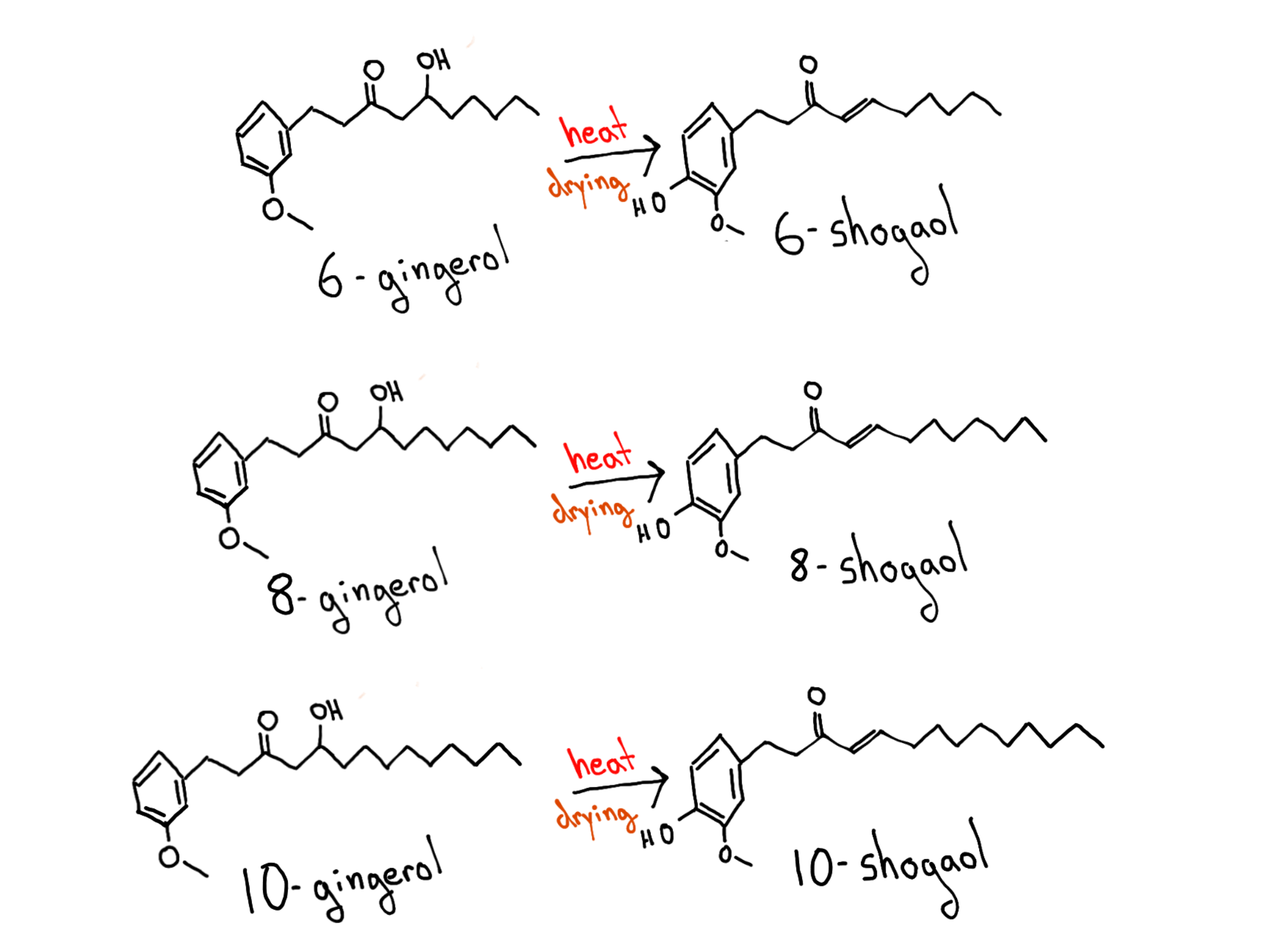
Both gingerols and shogoals have been studied in their purified form and are reported to act as anti-inflammatory, anti-cancer, and anti-nausea agents (Mao et al. 2019). One study even found that a 900 mg dose of dried ginger was equally effective against nausea compared to the regular dose of Dramamine, the medication often prescribed for nausea (Palatty et al. 2013). So if like me, you are prone to motion sickness, a ginger tablet may be a good idea the next time you are getting on a plane or, god forbid, a boat.
Bonus reading:
Bode, A.M. and Dong, Z., 2011. The amazing and mighty ginger. Herbal Medicine: Biomolecular and Clinical Aspects. 2nd edition.
Johnson, J.B., Mani, J.S., White, S., Brown, P. and Naiker, M., 2021. Pungent and volatile constituents of dried Australian ginger. Current research in food science, 4, pp.612-618.
Liu, H., Specht, C.D., Zhao, T. and Liao, J., 2020. Morphological anatomy of leaf and rhizome in Zingiber officinale Roscoe, with emphasis on secretory structures. HortScience, 55(2), pp.204-207.
Mao, Q.Q., Xu, X.Y., Cao, S.Y., Gan, R.Y., Corke, H., Beta, T. and Li, H.B., 2019. Bioactive compounds and bioactivities of ginger (Zingiber officinale Roscoe). Foods, 8(6), p.185.
Palatty, P.L., Haniadka, R., Valder, B., Arora, R. and Baliga, M.S., 2013. Ginger in the prevention of nausea and vomiting: a review. Critical reviews in food science and nutrition, 53(7), pp.659-669.
Zhan, K., Wang, C., Xu, K. and Yin, H., 2008. Analysis of volatile and non-volatile compositions in ginger oleoresin by gas chromatography-mass spectrometry. Chinese Journal of Chromatography, 26(6), pp.692-696.
18 Mar 2022
A few years ago, you might have read that red wine can help protect against heart disease, an exciting development for wine lovers worldwide. In the years since, however, there have been many conflicting reports on the health benefits of red wine. As a plant biologist, what interested me most when reading these articles was, of course, the plant itself. What exactly are grapes making that is so good for humans when consumed? And are there really enough of these health-promoting compounds in red wine to counteract the adverse effects of alcohol? Because, sadly, yes alcohol is bad for humans. (https://www.who.int/health-topics/alcohol).
The short answer to my first question is phenolics. Grapes produce an abundance of phenolic compounds in their skins which help to protect their seeds from insects, UV radiation, and infection by pathogens. Unlike white wine, when red wine is made, the skins are included in the fermentation process. This means that all phenolic compounds in the skin carry through to the final product. What’s more, during the fermentation, phenolic compounds are extracted from the grape skin and seed coat, meaning that there is considerably more phenolic content in wine than in a glass of grape juice.
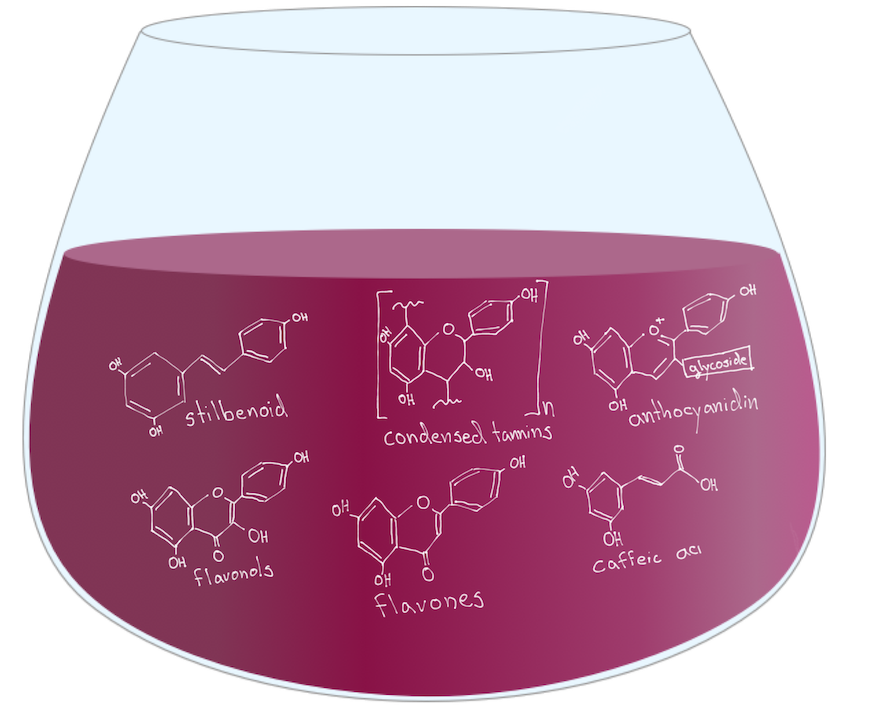
In a glass of red wine, you will find phenolics like condensed tannins, anthocyanidins, flavones, flavonols and stilbenes and while these compounds might look very complicated, you only need to focus on one thing: the phenolic component. These compounds all contain some form of an aromatic ring attached to at least one OH group, making them part of the chemical class termed “phenolics”.
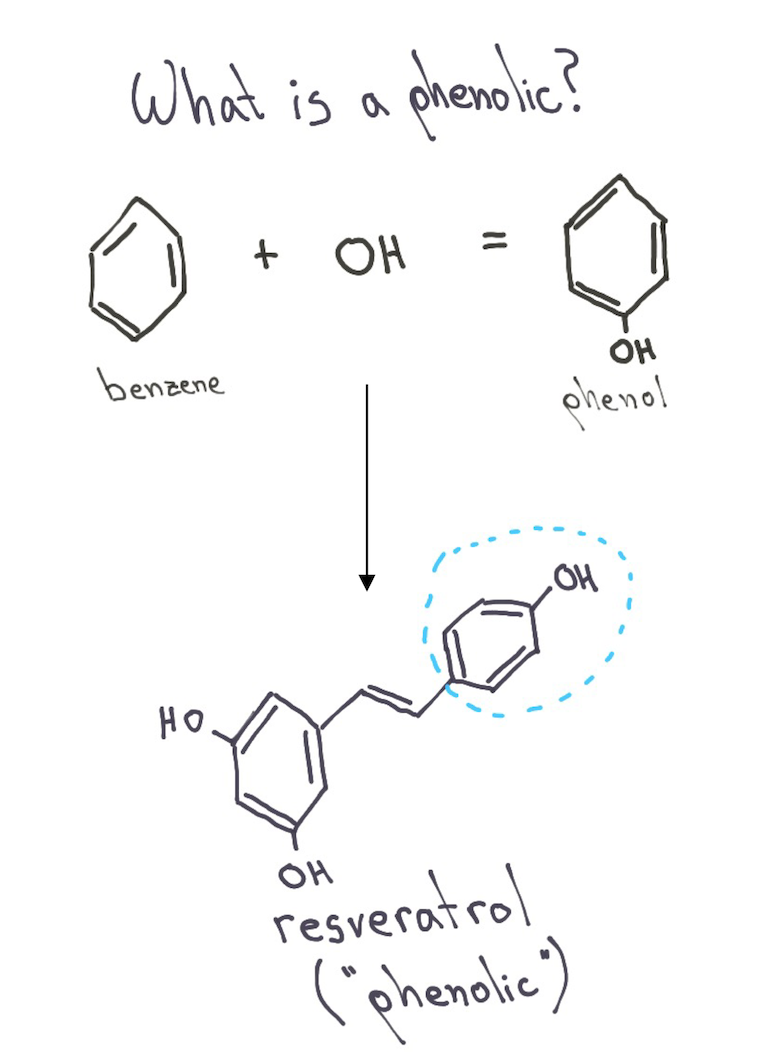
Phenolics are essential to plants because, first and foremost, they help to protect against the adverse effects of UV radiation. They also help mitigate the oxidative damage inside plant cells that can arise from drought stress, and other abiotic (non-living) stressors. This is what makes them antioxidants. In fact, it is widely believed that phenolics were essential to the evolution of land plants, by allowing their sensitive photosynthesizing cells to withstand UV radiation without the protection of water provided to their aquatic ancestors (Lattanzio et al. 2010).
Phenolics can also play other more specialized roles in a plant. For example, the anthocyanidins in red grapes are what give the skin a reddish-purple color. Condensed tannins, on the other hand, are very important in deterring insects and pests. Condensed tannins give wine a slightly bitter taste, making your tongue feel dry as you drink.
Resveratrol is a phenolic found in high amounts in grape skin, and subsequently red wine. The compound has garnered significant interest for its ability to act as an anticancer agent by preventing cell proliferation. It is also reported to promote heart health, protect against neurodegenerative disorders such as Alzheimer′s, Huntington′s, and Parkinson′s diseases as well as act as an anti-inflammatory agent (Salehi et al. 2018).
So why is resveratrol such a potent therapeutic?
One of the main reasons is that resveratrol is a powerful antioxidant when compared to many other plant phenolics. In fact, resveratrol is such a powerful antioxidant that it was once proposed as the answer to the “French Paradox, and could account for the good heart health of the French despite their consumption of more butter, cheese, and pork than their North American counterparts (Catalgol et al. 2012).
Unfortunately, one of the major problems with this hypothesis has to do with the therapeutic dose of resveratrol compared to the levels present in wine. Only around 70 plant species produce resveratrol, including grapevines, peanuts, and tomatoes. Of these plant species, grapes produce the highest amounts of resveratrol, especially in their skins. Red wines contain between 0.1 – 14.3 mg/L (Dudley et al. 2008), and most medical studies have shown that for resveratrol to be administered at a therapeutic dose, it must be at least 2.5 mg/kg (Mukherjee 2010). Meaning the average North American would need to consume at least 16 bottles of wine a day to start benefiting from resveratrol. Unfortunately, I think this is a dietary regime most doctors would recommend against.

Of course, you can always buy resveratrol supplements over the counter. These supplements are typically produced using genetically engineered yeast strains, the same type of yeast used for thousands of years in baking, beer brewing, and, ironically, winemaking. More recently, there has been some interest in finding ways to increase the amount of resveratrol made by grapes naturally. Researchers have found that when grapevines are subjected to stresses such as UV radiation, pathogen challenge, or even sonication, they upregulate the genes required to make resveratrol and increase the production by up to 2000 fold in some cases (Hassan and Bae 2016). So, there may be resveratrol enriched wines coming to a store near you!
Either way, whether you choose to drink a glass of red wine with dinner, snack on some grapes or take a supplement, resveratrol is one of the many wonderful plant compounds that help to keep us healthy and our cells free of oxidative stress!
Bonus Reading:
Catalgol, B., Batirel, S., Taga, Y. and Ozer, N.K., 2012. Resveratrol: French paradox revisited. Frontiers in pharmacology, 3, p.141.
Dudley, J., Das, S., Mukherjee, S. and Das, D.K., 2009. RETRACTED: Resveratrol, a unique phytoalexin present in red wine, delivers either survival signal or death signal to the ischemic myocardium depending on dose.
Lattanzio, V., Cardinali, A. and Linsalata, V., 2012. Plant phenolics: a biochemical and physiological perspective. Recent advances in polyphenols research. Chapter 1
Mukherjee, S., Dudley, J.I. and Das, D.K., 2010. Dose-dependency of resveratrol in providing health benefits. Dose-response, 8(4), pp.dose-response.
Salehi, B., Mishra, A.P., Nigam, M., Sener, B., Kilic, M., Sharifi-Rad, M., Fokou, P.V.T., Martins, N. and Sharifi-Rad, J., 2018. Resveratrol: A double-edged sword in health benefits. Biomedicines, 6(3), p.91
















